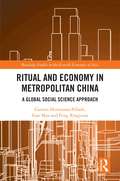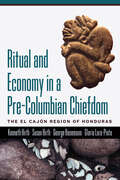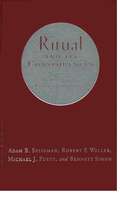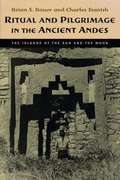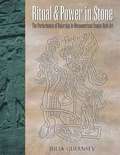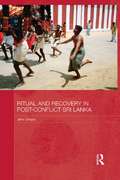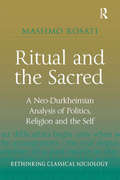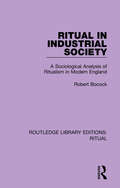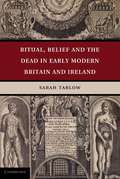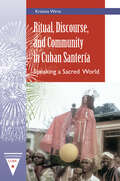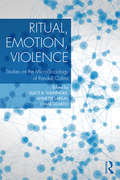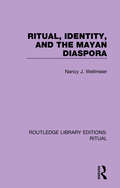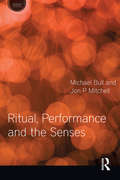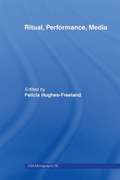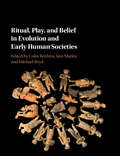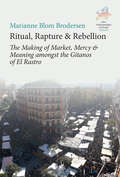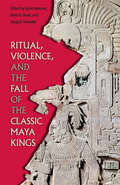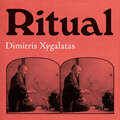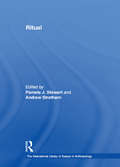- Table View
- List View
Ritual and Economy in Metropolitan China: A Global Social Science Approach (Routledge Studies in the Growth Economies of Asia)
by Carsten Herrmann-Pillath Guo Man Feng XingyuanThis book focuses on Shenzhen, one of China’s most globalized metropolises, a leading centre of high-tech industries and, as a melting pot of migrants from all over China, a place of vibrant cultural creativity. While in the early stages of Shenzhen’s development this vibrant cultural creativity was associated with the resilience of traditional social structures in Shenzhen’s migrant ‘urban villages’, today these structures undergird dynamic entrepreneurship and urban self-organization throughout Shenzhen, and have gradually merged with the formal structures of urban governance and politics. This book examines these developments, showing how important traditional social structures and traditional Chinese culture have been for China’s economic modernization. The book goes on to draw out the implications of this for the future of Chinese culture and Chinese economic engagement in a globalized world.
Ritual and Economy in a Pre-Columbian Chiefdom: The El Cajón Region of Honduras
by Kenneth Hirth Susan Hirth George Hasemann Gloria Lara-PintoThis volume examines the organization and ritual economy of a pre-Columbian chiefdom that developed in central Honduras over a 1,400-year period from 400 BC to AD 1000. Extremely applicable and broadly important to the archaeological studies of Mesoamerica, Ritual and Economy in a Pre-Columbian Chiefdom models the ritual organization of pre-Columbian societies across Honduras to expand the understanding of chiefdom societies in Central America and explore how these non-Maya societies developed and evolved. As part of the ritual economy, a large quantity of jade and marble artifacts were deposited as offerings in the ritual architecture of the El Cajón region’s central community of Salitrón Viejo. Over 2,800 of these high-value items were recovered from their original ritual contexts, making Salitrón Viejo one of the largest in situ collections of these materials ever recovered in the New World. These materials are well dated and tremendously varied and provide a cross-section of all jade-carving lapidary traditions in use across eastern Mesoamerica between AD 250 and 350. With a complementary website providing extensive additional description, visualization, and analysis (https://journals.psu.edu/opa/issue/view/3127), Ritual and Economy in a Pre-Columbian Chiefdom is a new and original contribution that employs an “economy of ritual approach” to the study of chiefdom societies in the Americas. It is a foundational reference point for any scholar working in Mesoamerica and Central America, especially those engaged in Maya research, as well as archaeologists working with societies at this scale of complexity in Latin America and around the world.
Ritual and Event: Interdisciplinary Perspectives (Routledge Advances in Theatre & Performance Studies)
by Mark FrankoRitual today can be encountered in the midst of catastrophic and transforming events. This collection reassesses and revises traditionally understood relationships between ritual and politics, ritual and everyday life, ritual and art making, and ritual and disaster. The methodologies as well as the subject matter are interdisciplinary: they range from the anthropological to the art and dance historical, from the theatrical and literary to the linguistic, philosophical, and psychoanalytic. It will be a valuable tool for scholars of Theater and Performance Studies, as well as Anthropology, Art, and History.
Ritual and Its Consequences: An Essay On The Limits Of Sincerity
by Adam B. Seligman Bennett Simon Robert P. Weller Michael J. PuettRitual and Pilgrimage in the Ancient Andes: The Islands of the Sun and the Moon
by Charles Stanish Brian S. BauerThe Islands of the Sun and the Moon in Bolivia's Lake Titicaca were two of the most sacred locations in the Inca empire. A pan-Andean belief held that they marked the origin place of the Sun and the Moon, and pilgrims from across the Inca realm made ritual journeys to the sacred shrines there. In this book, Brian Bauer and Charles Stanish explore the extent to which this use of the islands as a pilgrimage center during Inca times was founded on and developed from earlier religious traditions of the Lake Titicaca region. Drawing on a systematic archaeological survey and test excavations in the islands, as well as data from historical texts and ethnography, the authors document a succession of complex polities in the islands from 2000 BC to the time of European contact in the 1530s AD. They uncover significant evidence of pre-Inca ritual use of the islands, which raises the compelling possibility that the religious significance of the islands is of great antiquity. The authors also use these data to address broader anthropological questions on the role of pilgrimage centers in the development of pre-modern states.
Ritual and Power in Stone: The Performance of Rulership in Mesoamerican Izapan Style Art
by Julia GuernseyThe ancient Mesoamerican city of Izapa in Chiapas, Mexico, is renowned for its extensive collection of elaborate stone stelae and altars, which were carved during the Late Preclassic period (300 BC-AD 250). <P><P>Many of these monuments depict kings garbed in the costume and persona of a bird, a well-known avian deity who had great significance for the Maya and other cultures in adjacent regions. This Izapan style of carving and kingly representation appears at numerous sites across the Pacific slope and piedmont of Mexico and Guatemala, making it possible to trace political and economic corridors of communication during the Late Preclassic period.
Ritual and Recovery in Post-Conflict Sri Lanka: Eloquent Bodies (Routledge Contemporary South Asia Series)
by Jane DergesFollowing over twenty years of war, Sri Lanka’s longest cease-fire (2002-2006) provided a final opportunity for an inclusive peace settlement between the Sri Lankan government and the Liberation Tigers of Tamil Eelam (LTTE). However, hostilities resumed with ever increasing desperation and ferocity on both sides, until the LTTE were overcome and largely eradicated in 2009. This book provides a contextualised analysis of the effects of war on a small Tamil community living in northern Sri Lanka during the cease-fire period. It examines how the society changed and adapted in order to accommodate the upheaval and destruction of war, and its inevitable resumption. In particular, it focuses on the nature of suffering through an exploration of a well-known ritual: Thuukkukkaavadi that transformed the experience of pain and suffering and contributed to a process whereby many village communities could come together in a demonstration of strength and resilience. It contributes to studies on violence, reparation processes of so-called ‘post-conflict’ societies and the medical anthropology of healing. It questions assumptions concerning the nature of suffering and critiques the application of western categories in settings like northern Sri Lanka, where entire communities have been silenced by political violence. The book therefore presents a claim for more culturally specific understandings of what constitutes suffering and is of interest to students and scholars of South Asian Studies, Conflict Resolution, and Social and Cultural Anthropology.
Ritual and the Sacred: A Neo-Durkheimian Analysis of Politics, Religion and the Self (Rethinking Classical Sociology Ser.)
by Massimo RosatiRitual and the Sacred discusses some of the most important issues of modern socio-political life through the lens of a neo-Durkheimian perspective. Building on the main lesson of Durkheim's Elementary Forms of Religious Life, this book articulates values and practices common to non-Western and religious traditions that have the capacity to shape our modern way of living. Central to this volume is the question of modernity and scepticism with regard to mainstream Western wisdom; Rosati focuses on the notion of societal self-reassessment and self-revision, illustrating a willingness to learn from ’primitive’ societies. This reassessment necessitates us to rethink the central roles played by ritual and the sacred as building blocks of social and individual life, both of which remain salient features within the modern world. This title will be of key interest to sociologists of religion, philosophy politics and social theorists.
Ritual in Industrial Society: A Sociological Analysis of Ritualism in Modern England (Routledge Library Editions: Ritual #1)
by Robert BocockOriginally published in 1974, Ritual in Industrial Society is based on several years’ research including interviews and observations into the importance of ritual in industrial society within modern Britain. The book addresses how identity and meaning for people of all occupations and social classes can be derived through rituals and provides an expansive and diverse examination of how rituals are used in society, including in birth, marriage and death. The book offers an examination into the use of symbolic action in the body to articulate experiences which words cannot adequately handle and suggests that this enables modern men and women to overcome the mind-body splits which characterise modern technological society. In addition to this, the book examines ritual as a tool for articulating and sharing religious experiences, a point often overlooked by more intellectual approaches to religion in sociology. In addition to this, the book covers an exploration into ritual in social groups and how this is used to develop a sense of belonging among members. The book will be of interest to sociologists as well as academics of religion and theology, social workers and psychotherapists.
Ritual, Belief and the Dead in Early Modern Britain and Ireland
by Sarah TarlowDrawing on archaeological, historical, theological, scientific and folkloric sources, Sarah Tarlow's interdisciplinary study examines belief as it relates to the dead body in early modern Britain and Ireland. From the theological discussion of bodily resurrection to the folkloric use of body parts as remedies, and from the judicial punishment of the corpse to the ceremonial interment of the social elite, this book discusses how seemingly incompatible beliefs about the dead body existed in parallel through this tumultuous period. This study, which is the first to incorporate archaeological evidence of early modern death and burial from across Britain and Ireland, addresses new questions about the materiality of death: what the dead body means, and how its physical substance could be attributed with sentience and even agency. It provides a sophisticated original interpretive framework for the growing quantities of archaeological and historical evidence about mortuary beliefs and practices in early modernity.
Ritual, Discourse, and Community in Cuban Santería: Speaking a Sacred World (Contemporary Cuba)
by Kristina WirtzAn insightful ethnographic account of the lives of Santería practitioners in CubaHow do Santería practitioners in Cuba create and maintain religious communities amidst tensions, disagreements, and competition among them, and in the absence of centralized institutional authority? What serves as the "glue" that holds practitioners of different backgrounds together in the creation of a moral community? Examining the religious lives of santeros in Santiago de Cuba, Wirtz argues that these communities hold together not because members agree on their interpretations of rituals but because they often disagree.Religious life is marked by a series of "telling moments"—not only the moments themselves but their narrated representations as they are retold and mined for religious meanings. Long after they occur, spiritually elevated experiences circulate in narratives that may express skepticism or awe and hold the promise of more such experiences. The author finds that these episodes resonate in gossip and other forms of public commentary about the experiences of their fellow Santería practitioners.Drawing on ethnographic research about Santería beliefs and practices, Wirtz observes that practitioners are constantly engaged in reflection about what they and other practitioners are doing, how the orichas (deities) have responded, and what the consequences of their actions were or will be. By focusing their reflective attention on particular events, santeros re-create, moment to moment, what their religion is. Wirtz also argues that Santeria cannot be considered in isolation from the complex religious landscape of contemporary Cuba, in which African-based traditions are viewed with a mix of fascination, folkloric pride, and suspicion. Interactions among the conflicting discourses about these religions—as sacred practices, folklore, or dangerous superstitions, for example—have played a central role in constituting them as social entities. This book will interest scholars of religion, the African diaspora, the Caribbean, and Latin America, as well as linguistic and cultural anthropologists.
Ritual, Emotion, Violence: Studies on the Micro-Sociology of Randall Collins
by Annette Lareau Elliott B. Weininger Omar LizardoMicrosociologists seek to capture social life as it is experienced, and in recent decades no one has championed the microsociological approach more fiercely than Randall Collins. The pieces in this exciting volume offer fresh and original insights into key aspects of Collins’ thought, and of microsociology more generally. The introductory essay by Elliot B. Weininger and Omar Lizardo provides a lucid overview of the key premises this perspective. Ethnographic papers by Randol Contreras, using data from New York, and Philippe Bourgois and Laurie Kain Hart, using data from Philadelphia, examine the social logic of violence in street-level narcotics markets. Both draw on heavily on Collins’ microsociological account of the features of social situations that tend to engender violence. In the second section of the book, a study by Paul DiMaggio, Clark Bernier, Charles Heckscher, and David Mimno tackles the question of whether electronically mediated interaction exhibits the ritualization which, according to Collins, is a common feature of face-to-face encounters. Their results suggest that, at least under certain circumstances, digitally mediated interaction may foster social solidarity in a manner similar to face-to-face interaction. A chapter by Simone Polillo picks up from Collins’ work in the sociology of knowledge, examining multiple ways in which social network structures can engender intellectual creativity. The third section of the book contains papers that critically but sympathetically assess key tenets of microsociology. Jonathan H. Turner argues that the radically microsociological perspective developed by Collins will better serve the social scientific project if it is embedded in a more comprehensive paradigm, one that acknowledges the macro- and meso-levels of social and cultural life. A chapter by David Gibson presents empirical analyses of decisions by state leaders concerning whether or not to use force to deal with internal or external foes, suggesting that Collins’ model of interaction ritual can only partially illuminate the dynamics of these highly consequential political moments. Work by Erika Summers-Effler and Justin Van Ness seeks to systematize and broaden the scope of Collins’ theory of interaction, by including in it encounters that depart from the ritual model in important ways. In a final, reflective chapter, Randall Collins himself highlights the promise and future of microsociology. Clearly written, these pieces offer cutting-edge thinking on some of the crucial theoretical and empirical issues in sociology today.
Ritual, Heritage and Identity: The Politics of Culture and Performance in a Globalised World
by Christiane BrosiusThis book explores the importance of ritual and ritual theory to discourses of authenticity and originality, thereby deepening our insight into concepts of cultural heritage, identity and nation in a globalised world. The volume is the first interdisciplinary attempt to understand the significance of rituals and related performative traditions in the creation of grounded cultural identities, ‘home’ and heritage as geographically experienceable locations. It assembles perspectives from social and cultural anthropology, performance studies, education and arts that can deal with the politics of revitalisation and preservation of ritualised traditions. While some chapters in this book emphasise on the ritualisation of cultural heritage by concentrating on power relations and politics, as well as actual processes of identification, especially for marginalised ethnic groups or migrant communities, others explore how rituals as intangible heritage are strategically employed by different groups all over the world to make their claims public and to improve and negotiate their position on a local, national or global platform. This book recognises ritualised performances as transnational and cross-cultural phenomena, which are not only tied to and defined via national territories and identities but which also demand new theoretical and methodological approaches towards the discussion of rituals and heritage.
Ritual, History and Power: Selected Papers in Anthropology (London School Of Economics Monographs On Social Anthropology Ser. #Vol. 58)
by Maurice BlochThis volume provides a collection of some of Maurice Bloch's most important work, including influential essays on power, hierarchy, death and fertility.
Ritual, Identity, and the Mayan Diaspora (Routledge Library Editions: Ritual #5)
by Nancy J. WellmeierOriginally published in 1998, Ritual, Identity, and the Mayan Diaspora examines the lives and the continuing ritual traditions of the Mayas in the United States. The book focuses on a predominantly Maya town in rural Florida and shows how members of this ancient Central American civilization use their religious tradition to maintain their ethnic identity in an unfamiliar environment. Bringing together studies of Mesoamerican fiesta or cargo systems, religious ritual and migration studies, this interdisciplinary work describes the religious traditions of indigenous Guatemala, the crisis migration of the 1980s, and the Mayas' daily life in the United States, including Maya women's reflections on their new challenges. The book is unique in its focus on the transfer of the fiesta cycle to the diaspora and its analysis of the behind-the-scenes aspects of ritual. The rise of leadership contested interpretations of ethnic identity, choices about symbolic representation, and maintenance of ties to villages of origin all take place in the context of organizing public ritual events. This book will be of interest to academics of anthropology, history and sociology.
Ritual, Myth and the Modernist Text: The Influence of Jane Ellen Harrison on Joyce, Eliot and Woolf
by Martha C. CarpentierFirst Published in 1998. Routledge is an imprint of Taylor & Francis, an informa company.
Ritual, Performance and the Senses (Sensory Studies)
by Michael BullRitual has long been a central concept in anthropological theories of religious transmission. Ritual, Performance and the Senses offers a new understanding of how ritual enables religious representations – ideas, beliefs, values – to be shared among participants. Focusing on the body and the experiential nature of ritual, the book brings together insights from three distinct areas of study: cognitive/neuroanthropology, performance studies and the anthropology of the senses. Eight chapters by scholars from each of these sub-disciplines investigate different aspects of embodied religious practice, ranging from philosophical discussions of belief to explorations of the biological processes taking place in the brain itself. Case studies range from miracles and visionary activity in Catholic Malta to meditative practices in theatrical performance and include three pilgrimage sites: the Church of the Holy Sepulchre in Jerusalem, the festival of Ramlila in Ramnagar, India and the mountain shrine of the Lord of the Shiny Snow in Andean Peru.Understanding ritual allows us to understand processes at the very centre of human social life and humanity itself, making this an invaluable text for students and scholars in anthropology, cognitive science, performance studies and religious studies.
Ritual, Performance, Media: Performance, Media, Identity (ASA Monographs #No.35)
by Felicia Hughes-FreelandRitual, Performance and Media are significant areas of study which are essential to anthropology and are often surprisingly overlooked. This book brings a more anthropological perspective to debates about media consumption, performativity and the characteristics of spectacle which have transformed cultural studies over the past decade.
Ritual, Performance, and Politics in the Ancient Near East
by Lauren RistvetIn this book, Lauren Ristvet rethinks the narratives of state formation by investigating the interconnections between ritual, performance, and politics in the ancient Near East. She draws on a wide range of archaeological, iconographic, and cuneiform sources to show how ritual performance was not set apart from the real practice of politics; it was politics. Rituals provided an opportunity for elites and ordinary people to negotiate political authority. Descriptions of rituals from three periods explore the networks of signification that informed different societies. From circa 2600 to 2200 BC, pilgrimage made kingdoms out of previously isolated villages. Similarly, from circa 1900 to 1700 BC, commemorative ceremonies legitimated new political dynasties by connecting them to a shared past. Finally, in the Hellenistic period, the traditional Babylonian Akitu festival was an occasion for Greek-speaking kings to show that they were Babylonian and for Babylonian priests to gain significant power.
Ritual, Play and Belief, in Evolution and Early Human Societies
by Colin Renfrew Michael Boyd Iain MorleyThe origins of religion and ritual in humans have been the focus of centuries of thought in archaeology, anthropology, theology, evolutionary psychology and more. Play and ritual have many aspects in common, and ritual is a key component of the early cult practices that underlie the religious systems of societies in all parts of the world. This book examines the formative cults and the roots of religious practice from the earliest times until the development of early religion in the Near East, in China, in Peru, in Mesoamerica and beyond. Here, leading prehistorians, biologists, and other specialists bring a fresh approach to the early practices that underlie the faiths and religions of the world. They demonstrate the profound role of play ritual and belief systems and offer powerful new insights into the emergence of early societies.
Ritual, Rapture and Rebellion: The Making of Market, Mercy and Meaning Amongst the Gitanos of El Rastro (New Anthropologies of Europe: Perspectives and Provocations #9)
by Marianne Blom BrodersenThe Gitanos of el Rastro carry an ‘ontology of simultaneity’ as self-employed traders and Pentecostal practitioners in Madrid. This makes the Spanish Romani be considered as both a part of and apart from mainstream society. This book is an anthropological account of a group of middle and upper-class Gitanos and their ways of creating a ‘society within society’ based upon distinct cultural, moral and ideological values, notions and practices. The study renders a comprehensive perspective on social processes of classification, stratification, ‘othering’ and the role of ‘strangers’ in society and how these processes unfold in the interface between social, ritual and economic life on a local to global scale.
Ritual, Violence, and the Fall of the Classic Maya Kings (Maya Studies)
by Gyles Iannone Brett A. Houk Sonja A. SchwakeMaya kings who failed to ensure the prosperity of their kingdoms were subject to various forms of termination, including the ritual defacing and destruction of monuments and even violent death. This is the first comprehensive volume to focus on the varied responses to the failure of Classic period dynasties in the southern lowlands. The contributors offer new insights into the Maya "collapse," evaluating the trope of the scapegoat king and the demise of the traditional institution of kingship in the early ninth century AD--a time of intense environmental, economic, social, political, and even ideological change. A volume in the series Maya Studies, edited by Diane Z. Chase and Arlen F. Chase
Ritual: How Seemingly Senseless Acts Make Life Worth Living
by Dimitris XygalatasRitual is perhaps the oldest, and certainly the most enigmatic, thread in human culture. Seemingly pointless ceremonies pervade every known society: from handshakes to hexes, hazings to parades, birthdays to graduations. Before we ever learned to farm, we were gathering in giant stone temples. And yet, though rituals exist in every culture and can persist nearly unchanged for centuries, their logic has remained a mystery until now.Today, a fearless new generation of anthropologists is venturing into this shadowy realm. Armed with cutting-edge technology and drawing on discoveries from a wide range of disciplines, they emerge with a powerful new perspective on our place in the world. Pathfinding scientist Dimitris Xygalatas reveals the deep and subtle mechanisms that bind us together.
Ritual: How Seemingly Senseless Acts Make Life Worth Living
by Dimitris XygalatasA pioneering anthropologist takes readers on a 'fascinating, well-researched' (Dr. Jane Goodall, DBE) journey through the rich tapestry of human ritual—showing how and why our most irrational behaviors are a key driver of our success." Ritual is one of the oldest, and certainly most enigmatic, threads in the history of human culture. It presents a profound paradox: people ascribe the utmost importance to their rituals, but few can explain why they are so important. Apparently pointless ceremonies pervade every documented society, from handshakes to hexes, hazings to parades. Before we ever learned to farm, we were gathering in giant stone temples to perform elaborate rites and ceremonies. And yet, though rituals exist in every culture and can persist nearly unchanged for centuries, their logic has remained a mystery—until now. In Ritual, pathfinding scientist Dimitris Xygalatas leads us on an enlightening tour through this shadowy realm of human behavior. Armed with cutting-edge technology and drawing on discoveries from a wide range of disciplines, he presents a powerful new perspective on our place in the world. In birthday parties and coronations, in silent prayer, in fire-walks and terrifying rites of passage, in all the bewildering variety of human life, Ritual reveals the deep and subtle mechanisms that bind us together.
Ritual: Key Concepts In Religion (The International Library of Essays in Anthropology #3)
by Andrew StrathernThis volume consists of a number of carefully-selected readings that represent a wide range of discussions and theorizing about ritual. The selection encompasses definitional questions, issues of interpretation, meaning, and function, and a roster of ethnographic and analytical topics, covering classic themes such as ancestor worship and sacrifice, initiation, gender, healing, social change, and shamanic practices, as well as recent critical and reconstructive theorizing on embodiment, performance, and performativity. In their Introduction to the volume, the Editors provide an overall survey and critical consideration of topics, incorporating insights from their own long-term field research and reflections on the readings included. The Introduction and readings together provide a unique research tool for those interested in pursuing the study of ritual processes in depth, with the benefit of both historical and contemporary approaches.
